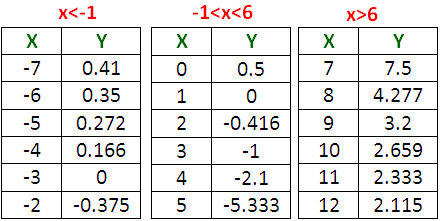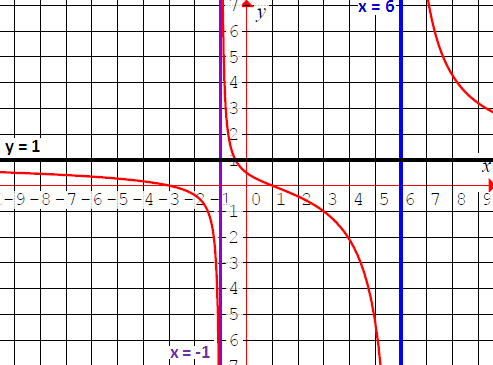GRAPHING RATIONAL FUNCTIONS
A rational function is a function which is a fraction where both numerator and denominator are polynomials.
That is, a ratio of two polynomials P(x) and Q(x), where the denominator Q(x) is not equal to zero.

Before we learn, how to graph rational functions, first we have to be aware of the following stuff.
Please click on each topic above to know more about the stuff.
Now let us look at an example to understand how to graph rational functions.
Example :
Graph the rational function given below.

Solution :
Step 1 :
First, we have to find hole, if any.
To find hole of the rational function, we have to see, whether there is any common factor found at both numerator and denominator.
So, let us factor both numerator and denominator.
y = [(x + 3)(x - 1)] / [(x - 6)(x + 1)]
In our problem, clearly there is no common factor found at both numerator and denominator.So, there is no hole.
Step 2 :
Now, we have to find vertical asymptote, if any.
Most of the rational function will have vertical asymptote.
To find vertical asymptote, we have to make the denominator equal to zero.
Then,
When we do so,
x2 - 5x - 6 = 0
(x - 6)(x + 1) = 0
x - 6 = 0 or x + 1 = 0
x = 6 or x = -1
So, the two vertical asymptotes are
x = -1
x = 6
Step 3 :
Now we have to find horizontal asymptote, if any.
In the rational function given above, the highest exponent of the numerator and denominator are equal. So there is an horizontal asymptote.
Equation of the horizontal asymptote :
y = a/b
Here 'a' and 'b' are the coefficients of highest exponent terms at the numerator and denominator respectively.
In our problem, a = 1 and b = 1.
So, horizontal asymptote is
y = 1/1
y = 1
Step 4 :
Now we have to find slant asymptote, if any.
Since there is horizontal asymptote, there is no slant asymptote.
Step 5 :
In the given rational function, now we have to plug some random values for 'x' and find the corresponding values of 'y'.
We have already known that the vertical asymptote are
x = -1
x = 6
Now, we have to take some random values for x in the following intervals.
(x < -1), (-1 < x < 6), (x > 6)
but not x = -1 and x = 6
(Because, x = -1 and x = 6 are vertical asymptotes)

Graph of the Given Rational Function

Kindly mail your feedback to v4formath@gmail.com
We always appreciate your feedback.
©All rights reserved. onlinemath4all.com
Recent Articles
-
Logarithmic Derivative Problems and Solutions
Apr 16, 25 09:25 PM
Logarithmic Derivative Problems and Solutions -
Digital SAT Math Problems and Solutions (Part - 145)
Apr 16, 25 12:35 PM
Digital SAT Math Problems and Solutions (Part - 145) -
Digital SAT Math Problems and Solutions (Part - 144)
Apr 14, 25 07:27 PM
Digital SAT Math Problems and Solutions (Part - 144)

